 | |
| Category | Sans-serif |
|---|---|
| Classification | Neo-grotesque |
| Designer(s) | URW Studio |
| Foundry | URW++ |
| Date released | 1999 |
| Design based on | Helvetica |
| Variations | URW Heisei Gothic |
Nimbus Sans is a sans-serif typeface created by URW++, based on Helvetica.
 | |
| Category | Sans-serif |
|---|---|
| Classification | Neo-grotesque |
| Designer(s) | URW Studio |
| Foundry | URW++ |
| Date released | 1999 |
| Design based on | Helvetica |
| Variations | URW Heisei Gothic |
Nimbus Sans is a sans-serif typeface created by URW++, based on Helvetica.
It is a version using URW++ font source. The family supports Western Europe, East Europe, Turkish, Baltic, and Romanian languages.
The font names ending with (D) have slightly lighter font weights and tighter spacing.
| Weight | condensed | medium | extended |
|---|---|---|---|
| Black | roman | roman, italic | roman |
| Bold | roman | roman, italic | roman |
| Regular | roman | roman, italic | roman |
| Light | - | roman, italic | roman |
| (D) fonts | |||
| Weight | condensed | medium | extended |
| Black | roman, italic | roman, italic | roman, outline |
| Bold | roman, italic | roman, italic, outline | roman |
| Regular | roman, italic | roman, italic | roman |
| Light | roman, italic | roman, italic | roman |
| Ultra Light | - | roman | - |
It is a version of Nimbus Sans with even tighter spacing than the Nimbus Sans (D) fonts. Other changes include alternate designs for currency symbols.
| Weight | condensed | medium |
|---|---|---|
| Black | roman, italic | roman, italic |
| Bold | roman, italic | roman, italic |
| Regular | roman, italic | roman, italic |
| Light | roman, italic | roman, italic |
| Ultra Light | - | roman |
It is a version with more right lean than Nimbus Sans italic fonts. The family currently only includes 1 font, in Black weight in medium width.
It is a monospaced variant of Nimbus Sans. The family currently only includes 1 font, in Regular weight in medium width.
It is a family supporting Latin, Greek, Cyrillic, CJK ideographic, Japanese kana, Korean Hangul syllables, Thai characters. The family includes 5 fonts in 1 (medium) width, with 4 proportional and 1 monospaced fonts. The proportional fonts are in 4 weights (bold, medium, regular, light), while the monospace font is in medium weight.
Nimbus Sans L is a version of Nimbus Sans using Adobe font sources. It was designed in 1987. The family includes 17 fonts in 5 weights and 2 widths, with Nimbus Sans L Extra Black only available in condensed roman format.
A subset of Nimbus Sans L, which includes regular and bold weight fonts in all widths and styles, were released under the GPL and AFPL in Type 1 format in 1996 [1] [2] [3] [4] [5] [6] and LPPL in 2009, [7] and is one of several freely licensed fonts offered by URW++.
Although the characters are not exactly the same, Nimbus Sans L has metrics almost identical to Helvetica and Arial. Nimbus Sans L is one of the Ghostscript fonts, a set of free alternatives to the 35 basic PostScript fonts (which include Helvetica). [8] [9] [10] [11]
It is a standard typeface in many Linux distributions. [12] It was used as default font in OpenOffice.org Calc and Impress in some Linux distributions (e.g. Ubuntu - up to version 8.10; since Ubuntu 9.04 the default font was changed to Liberation Sans).
It was extended to include Cyrillic support by Valek Filippov.
It is a version using Linotype's Stempel Studio source, based on Neue Helvetica, but without the extended width.

While the design of the characters is based on Neue Helvetica, the two typefaces differ metrically: Nimbus Sans Novus has smaller x-height and is narrower at the same font size (but not at the same x-height).
The weight systems of the two typefaces also drastically differ. For instance, the Regular weight of Nimbus Sans Novus resembles the Light weight of Neue Helvetica, while the Medium weight of Nimbus Sans Novus resembles the Regular Neue Helvetica design. Nimbus Sans Novus has a Semibold weight, but Neue Helvetica does not.
The font names ending with (D) have tighter letter spacing.
| Weight | condensed | medium | |
|---|---|---|---|
| Ultra | roman, italic | - | |
| Black | roman, italic | roman, italic | |
| Heavy | roman, italic | roman, italic | |
| Bold | roman, italic | roman, italic, outline | |
| Semi Bold | roman, italic | roman, italic | |
| Medium | roman, italic | roman, italic | |
| Regular | roman, italic | roman, italic | |
| Light | roman, italic | roman, italic | |
| Ultra Light | roman, italic | roman, italic | |
| (D) fonts | |||
| Weight | condensed | medium | |
| Ultra | roman | - | |
| Black | roman | roman, outline | |
| Heavy | roman | roman | |
| Bold | roman | roman | |
| Semi Bold | roman | roman | |
| Medium | roman | roman | |
| Regular | roman | roman | |
| Light | roman | roman | |
| Ultra Light | roman | roman | |
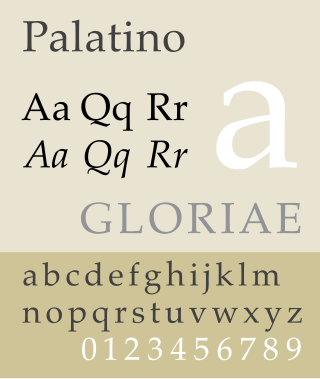
Palatino is the name of an old-style serif typeface designed by Hermann Zapf, initially released in 1949 by the Stempel foundry and later by other companies, most notably the Mergenthaler Linotype Company.
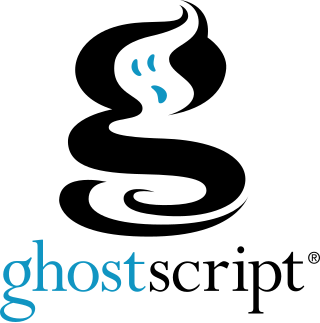
Ghostscript is a suite of software based on an interpreter for Adobe Systems' PostScript and Portable Document Format (PDF) page description languages. Its main purposes are the rasterization or rendering of such page description language files, for the display or printing of document pages, and the conversion between PostScript and PDF files.

A typeface is a design of letters, numbers and other symbols, to be used in printing or for electronic display. Most typefaces include variations in size, weight, slope, width, and so on. Each of these variations of the typeface is a font.
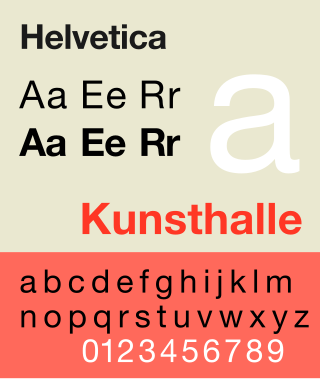
Helvetica, also known by its original name Neue Haas Grotesk, is a widely used sans-serif typeface developed in 1957 by Swiss typeface designer Max Miedinger and Eduard Hoffmann.

Arial is a sans-serif typeface and set of computer fonts in the neo-grotesque style. Fonts from the Arial family are included with all versions of Microsoft Windows after Windows 3.1, as well as in other Microsoft programs, Apple's macOS, and many PostScript 3 printers.
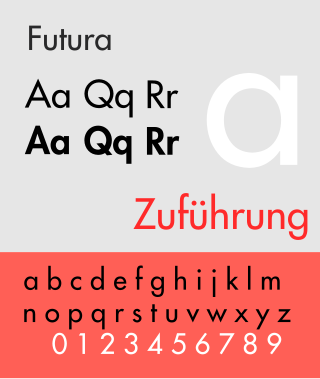
Futura is a geometric sans-serif typeface designed by Paul Renner and released in 1927. It was designed as a contribution on the New Frankfurt-project. It is based on geometric shapes, especially the circle, similar in spirit to the Bauhaus design style of the period. It was developed as a typeface by the Bauer Type Foundry, in competition with Ludwig & Mayer's seminal Erbar typeface of 1926.

Univers is a large sans-serif typeface family designed by Adrian Frutiger and released by his employer Deberny & Peignot in 1957. Classified as a neo-grotesque sans-serif, one based on the model of nineteenth-century German typefaces such as Akzidenz-Grotesk, it was notable for its availability from the moment of its launch in a comprehensive range of weights and widths. The original marketing for Univers deliberately referenced the periodic table to emphasise its scope.
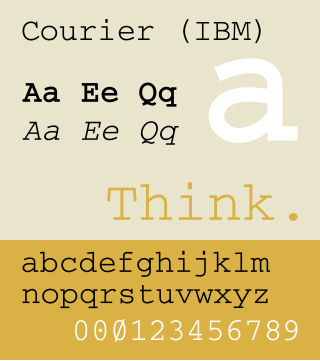
Courier is a monospaced slab serif typeface. Courier was created by IBM in the mid-1950s, and was designed by Howard "Bud" Kettler (1919–1999). The Courier name and typeface concept are in the public domain. Courier has been adapted for use as a computer font, and versions of it are installed on most desktop computers.

Lucida is an extended family of related typefaces designed by Charles Bigelow and Kris Holmes and released from 1984 onwards. The family is intended to be extremely legible when printed at small size or displayed on a low-resolution display – hence the name, from 'lucid'.

There are Unicode typefaces which are open-source and designed to contain glyphs of all Unicode characters, or at least a broad selection of Unicode scripts. There are also numerous projects aimed at providing only a certain script, such as the Arabeyes Arabic font. The advantage of targeting only some scripts with a font was that certain Unicode characters should be rendered differently depending on which language they are used in, and that a font that only includes the characters a certain user needs will be much smaller in file size compared to one with many glyphs. Unicode fonts in modern formats such as OpenType can in theory cover multiple languages by including multiple glyphs per character, though very few actually cover more than one language's forms of the unified Han characters.

Century Gothic is a digital sans-serif typeface in the geometric style, released by Monotype Imaging in 1991. It is a redrawn version of Monotype's own Twentieth Century, a copy of Bauer's Futura, to match the widths of ITC Avant Garde Gothic. It is an exclusively digital typeface that has never been manufactured as metal type.

In metal typesetting, a font is a particular size, weight and style of a typeface. Each font is a matched set of type, with a piece for each glyph. A typeface consists of various fonts that share an overall design.

Thesis is a large typeface family designed by Luc(as) de Groot. The typefaces were designed between 1994 and 1999 to provide a modern humanist family. Each typeface is available in a variety of weights as well as in italic. Originally released by FontFont in 1994, it has been sold by de Groot through his imprint LucasFonts since 2000.
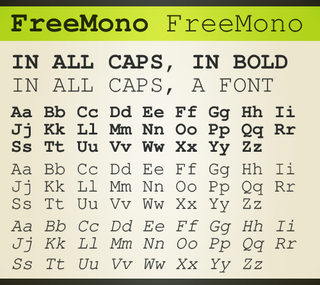
GNU FreeFont is a family of free OpenType, TrueType and WOFF vector fonts, implementing as much of the Universal Character Set (UCS) as possible, aside from the very large CJK Asian character set. The project was initiated in 2002 by Primož Peterlin and is now maintained by Steve White.

Liberation is the collective name of four TrueType font families: Liberation Sans, Liberation Sans Narrow, Liberation Serif, and Liberation Mono. These fonts are metrically compatible with the most popular fonts on the Microsoft Windows operating system and the Microsoft Office software package, for which Liberation is intended as a free substitute. The fonts are default in LibreOffice.

Nimbus Roman is a serif typeface created by URW Studio in 1982.
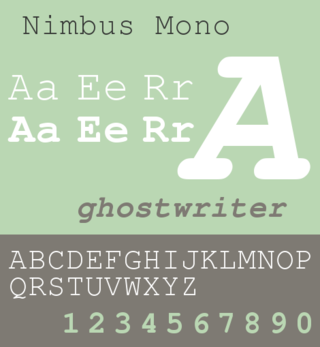
Nimbus Mono is a monospaced typeface created by URW Studio in 1984, and eventually released under the GPL and AFPL in 1996 and LPPL in 2009. In 2017, the font, alongside other Core 35 fonts, has been additionally licensed under the terms of OFL. It features Normal, Bold, Italic, and Bold Italic weights, and is one of several freely licensed fonts offered by URW++. Although not exactly the same, Nimbus Mono has metrics and glyphs that are very similar to Courier and Courier New.
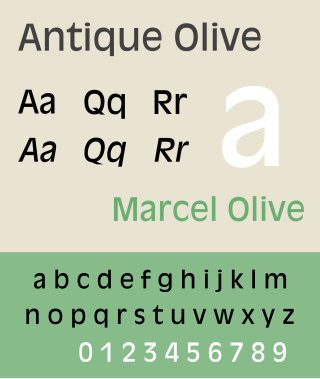
Antique Olive is a humanist sans-serif typeface. Along the lines of Gill Sans, it was designed in the early 1960s by French typographer Roger Excoffon, an art director and former consultant to the Marseilles based Fonderie Olive. In addition to a basic weight, Antique Olive was produced in medium, condensed, wide, bold, condensed bold, extra bold, and ultra bold. The key shapes, especially the letter O, resemble an olive, which is one of the characteristics which make Excoffon's typefaces unique. It was used in the Sesame Street ending credits from 1978-1983.

URW Type Foundry GmbH is a type foundry based in Hamburg, Germany. The foundry has its own library with more than 500 font families. The company specializes in customized corporate typefaces and the development of non-Latin fonts. It has been owned by Monotype Imaging since May 2020.